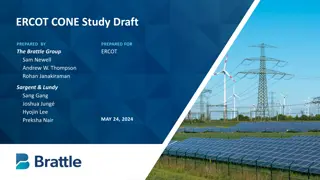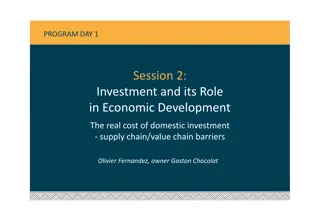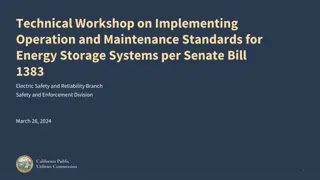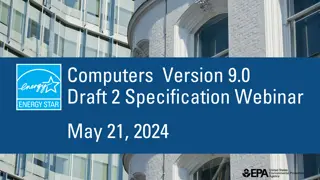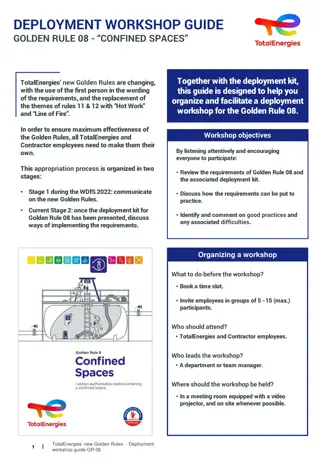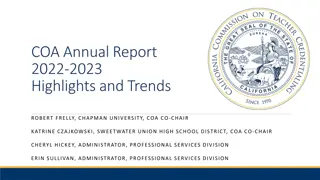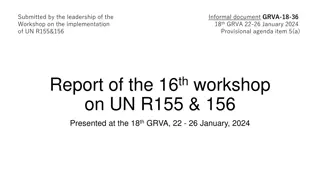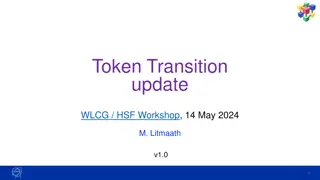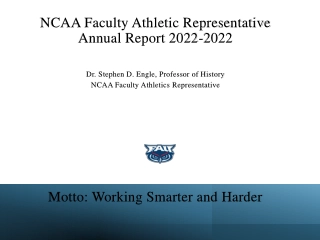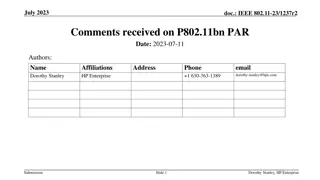2022 CPUC Draft Avoided Cost Calculator Workshop Highlights
The 2022 CPUC Draft Avoided Cost Calculator Workshop discussed various topics including comparisons with 2021, new methods for annualization, natural gas values, and more. The draft ACC shows higher avoided costs in multiple categories, such as generation capacity, distribution, transmission, and energy prices. Significant changes are observed, including increased natural gas avoided costs and adjustments in greenhouse gas values.
Download Presentation
Please find below an Image/Link to download the presentation.
The content on the website is provided AS IS for your information and personal use only. It may not be sold, licensed, or shared on other websites without obtaining consent from the author. Download presentation by click this link. If you encounter any issues during the download, it is possible that the publisher has removed the file from their server.
Presentation Transcript
2022 CPUC Draft Avoided Cost Calculator Workshop June 30, 2022 California Public Utilities Commission
General Information This workshop will be recorded and the recording and the slides will be made available. Please use the raise hand function if you want ask a question verbally and we will unmute you. Please use the Q&A function to ask questions. (That leaves the chat free for general announcements.) Q&A Panel Lower-Right Raise Hand Lower-Middle Participants Panel Upper-Right Unmute A host will unmute you then you must click button to unmute yourself California Public Utilities Commission 2
2022 CPUC Draft Avoided Cost Calculator Workshop 06/30/2022
Agenda Topic Presenter Approximate Time Introduction Energy Division 9:00 9:05 am Comparison of 2022 and 2021 ACC E3 9:05 9:15 am Discussion of No New DER scenario and overview of SERVM data + discussion Energy Division / E3 9:15 9:55 am New method for annualization for generation capacity E3 9:55 10:05 am California Large Energy Consumers Association (CLECA) Presentation CLECA 10:05 10:15 am Discussion of GC annualization method & CLECA Presentation E3 / CLECA / Stakeholders 10:15 10:25 am Using SERVM instead of RECAP for allocation of generation capacity value + discussion Energy Division / E3 10:25 10:40 am Transmission and Distribution, including secondary distribution + discussion E3 10:40 11:10 am Break 11:10 11:20 am Changes to natural gas values, now using IEPR + discussion E3 11:20 11:30 am Interim natural gas GHG adder + discussion E3 11:30 11:50 am Avoided Gas Infrastructure Cost (AGIC) + discussion Energy Division / E3 11:50 12:00 pm Refrigerant Calculator + discussion E3 12:00 12:10 pm Solar Energy Industry Association (SEIA) presentation + discussion SEIA 12:10 12:30 pm 4
Comparison of Results with 2021 ACC
2022 Draft Avoided Cost Calculator (ACC) sees higher avoided costs across several categories in near and mid term 2021 ACC Electric Avoided Costs 2030 PG&E CZ12 Higher generation capacity avoided costs based on net costs of storage Higher short-term distribution capacity avoided costs for PG&E Higher transmission capacity avoided costs for PG&E Higher energy prices during the middle of the day from SERVM around 2030 Lower greenhouse gas (GHG) value from RESOLVE Natural Gas Avoided Costs Natural gas avoided costs double as 2022 ACC adopts separate GHG value for the natural gas sector to reflect the higher costs to decarbonize gas 2022 ACC 2030 PG&E CZ12 6
Energy Efficiency & Solar 2030 PG&E CZ12 Energy efficiency or solar will see an increase in avoided costs if they can capture high-capacity hours in summer and high midday energy prices 2021 ACC 2022 ACC 7
Electrification 2030 PG&E CZ12* Electrification measures (e.g., heat pump for space heating) that avoid natural gas consumption will see an improvement in cost effectiveness Increased natural gas avoided costs due to higher natural gas GHG value Decreased incurred electricity costs due to winter consumption *This slide has been revised after the workshop to address a small mistake in pulling the wrong data from ACC. 8
Removing All DER Results in Lower Annual and Peak Load 2022 ACC removes all incremental load reducing (e.g., solar, storage, EE) and load increasing (e.g., building and transportation electrification) DER in the No New DER scenario It generally results in lower annual and peak load compared to the Preferred System Plan (PSP) It also results in low GHG value because of two major reasons: With the same emission cap, lower annual load makes it easier for system to meet the emission target No New DER scenario results in higher peak load in 2030. The system builds batteries for capacity needs, and they help meet the GHG target by reducing the curtailments of renewables, putting downward pressure on GHG value Annual Load (GWh) Peak Load (GW) The impact of removing energy efficiency outweighs the impact of removing electrification on peak load 10 *Annual load does not reflect the impact of removing BTM PV and storage (modeled as supply side resource in RESOLVE)
2022 ACC GHG Value Drops Compared to 2021 ACC RESOLVE total GHG value stays at the cap-and- trade value and shows zero GHG adder in 2030 2022 ACC GHG value is extrapolated from the GHG value in 2035 from RESOLVE using utility WACC GHG value drops by a half compared to 2021 ACC GHG Value Extrapolated in 2022 ACC GHG Value Extrapolated in 2021 ACC 11
Comparison of Selected Resource Capacity Near term additions in PSP include the procurement order. The No New DER scenario builds more storage for capacity needs In the long term, the No New DER scenario builds less resources due to lower load, but still with significant amount of solar penetration Includes 11.5GW procurement order between 2023-2026 12
SERVM Scarcity Adjusted Energy Prices SERVM is used to forecast energy and ancillary services prices for ACC because IRP has validated resource portfolios in SERVM 2022 ACC makes an improvement to have price forecasts to 2045 to capture long term price dynamics Near term energy price patterns are consistent with the 2021 historical prices with low prices during spring month and high prices in summer evenings Lower energy prices in the middle of the day with increased solar penetration 14
SERVM Ancillary Service Prices - Reg SERVM AS prices need further evaluation Near term SERVM AS prices are low compared to historical prices during the summer peak hours Long term SERVM AS prices remain flat 15
SERVM Implied Heat Rates Acknowledging the discrepancy between the natural gas price forecasts used in SERVM (comes from 2020 IEPR) and market prices, implied heat rate is used for benchmarking Near term SERVM prices are close to historical 2021 implied heat rate Scarcity adjustment limited to 5% to ensure the equation best captures the dynamics during the highest- demand hours In the long term, more zero price hours due to renewable penetration 2022 2030 2045 16
Responses to Stakeholder Comments Market Price Trends Driven by both storage and solar dynamics. Renewable penetration increases each year, but storage penetration increase is not uniform. Net flattening effect from 2022-2029. Steepening effect 2030+. 17
Responses to Stakeholder Comments Negative Market Prices Negative prices only occur when the system is curtailing renewable energy. A bid curve is used in SERVM to identify the lowest cost resource to curtail which sets the marginal energy cost. We expect a trend of decreasing negative prices from 2023 to 2029 and continuing after that, since we expect continued deployment of storage to flatten price differences during the day. Staff will look into 2030 values and confirm in the final ACC. Ancillary Service Pricing SERVM uses an opportunity cost calculation to determine the ancillary service prices each hour. This function was disabled in the draft ACC leading to lower AS prices as we were continuing to evaluate results. We will fix it in the final ACC. 18
Generation Capacity Avoided Costs E3 Presentation
Drivers of changes in 2022 Gen Capacity Avoided Costs apacity alue 1. Switch from weighted average Effective Load Carrying Capability (ELCC) to marginal ELCC from IRP 300 202 2022 Nominal k yr E 2 0 200 0 ACC is evaluating DERs as marginal resources 00 Reduced capacity contribution of storage in later years increases avoided costs 0 0 2. Lower near-term AS prices, less volatile long- term energy prices from SERVM 2022 20 2020 202 202 202 2030 2032 203 203 203 20 0 20 2 20 20 20 0 20 2 Reduced storage revenues increases avoided costs E 00 3. Switching methodology from First-Year Net CONE to RECC 0 0 Increases avoided costs in early years, consistent with deferral of assets with declining costs 0 202 erage E 20 4. Slightly lower storage cost estimates from latest IRP cycle 2022 arginal E 0 2020 2022 202 202 202 2030 2032 203 203 203 20 0 20 2 20 20 20 20 0 20 2 20
RECC Methodology Real Economic Carrying Charge (RECC) calculates the value of deferring an investment in the marginal resource (storage) by one year Looks at the net costs (costs minus revenues) over the lifetime of the resource Compares that to the net costs of the same resource installed the following year Compensates resources from all vintages such that their avoided costs offset full NPV net costs Year Illustrative Example 2 3 25 26 NPV 1 Investment in Year 1 $1,045 $70 $70 $70 $70 $32 Investment in Year 2 $958 $0 $68 $68 $68 $68 Difference $87 RECC In contrast, the First-Year Net CONE approach (used in previous ACCs) considers only the first- year net costs of a resource If the cost of a resource declines over time, the First-Year Net CONE approach undercompensates resources installed in earlier years as the price is set by cheaper resources installed in later years 21
Capacity Value Calculation Walk-through part 1 1. Determine storage costs Based on 4hr utility-scale storage costs from IRP Upfront costs of new battery vintages are assumed to decline over time Resource cost pro forma from IRP converts upfront cost into a real levelized cost, which is flat in real dollars (increases at inflation in nominal dollars) Assumed replacement cost after lifetime also reflects assumed technology cost declines e eli ed i ed Replacement ost by intage 20 k yr Vintage 202 0 2022 20 2023 20 k yr 00 202 0 202 0 0 202 Levelized cost of new battery vintages decline over time Replacement cost after lifetime is assumed to decline 20 202 202 202 2022 2023 202 202 202 202 202 202 2030 203 2032 2033 203 203 perational ear 203 203 203 203 20 0 20 20 2 20 3 20 20 20 20 20 20 20 0 20 20 2 202 2030 22
Capacity Value Calculation Walk-through part 2 2. Determine storage revenues E3 RESTORE modelling of 4hr storage using SERVM prices Varies by year. Net osts 2022 intage 0 3. Calculate net cost of storage 20 k yr nameplate 20 Net Costs = Storage Costs Storage Revenues 00 0 Varies by year and by vintage of storage 0 0 Re enues osts Net osts 20 2032 20 2 2022 2023 202 202 202 202 202 202 2030 203 2033 203 203 203 203 203 203 20 0 20 23
Capacity Value Calculation Walk-through part 3 4. Calculate the deferral value (RECC) RECC = NPV(Net Costs X Vintage) NPV(Net Costs (X + 1) Vintage) apacity alue 300 5. Adjust deferral value based on marginal ELCC of storage RE k yr nameplate RE k yr E 2 0 Nominal k yr 200 0 00 0 202 2023 202 202 202 203 2033 203 203 203 20 20 3 20 20 20 20 24
Generation Capacity Avoided Costs CLECA Presentation
Using SERVM for Capacity Factor Allocation
Near-term EUE Comparison The 2022 ACC uses SERVM instead of RECAP for capacity factor allocation to be consistent with IRP SERVM s expected unserved energy (EUE) heatmap is used to allocate the generation capacity values to hours when the system needs the capacity In the near term, SERVM shows EUE at 5-7 PM in September, consistent with 2021 ACC 2021 ACC using RECAP [2020] 2022 ACC using SERVM [2022] 39
2030 EUE Comparison SERVM s EUE peaks at 6-7 PM in August, while RECAP s EUE peaks at 10 PM in September 2021 ACC using RECAP [2030] 2022 ACC using SERVM [2030] 40
Transmission and Distribution
T&D - Continuation of Existing Methodology Derivation of Transmission and Distribution inputs maintains consistent with the methodology used in prior ACCs, with values updated based on the most recent filings Component Data Source Calculations* Use of 2019 T&D White Paper methodology to determine overloads and resulting upgrade costs in a scenario with no new DER Weighted grouping of utility-filed costs by climate zone (PG&E); Sum of individual cost components presented in filing (SCE, SDG&E) Near Term Marginal Distribution Cost Utility GNA + DDOR Filings Long Term Marginal Distribution Cost Utility GRC Filings Utility supplied per recent CPUC ruling (PG&E); LNBA method for system-wide transmission projects (SCE); DTIM approach (SDG&E) Utility GRC Filings and supplemental data requests for marginal cost factors Marginal Transmission Cost Hourly Allocation of Transmission Avoided Capacity Costs Peak Capacity Allocation Factor (PCAF) method with values realigned to match temperatures in a typical weather year CAISO Energy Management dataset Peak Capacity Allocation Factor (PCAF)-equivalent method (calculated by utilities for PG&E, SCE) with values realigned to match temperatures in a typical weather year Hourly Allocation of Distribution Avoided Capacity Costs Utility GRC Phase II (PG&E, SCE); Utility Supplied Load Data (SDG&E) *See 2022 ACC Documentation Appendix 14.3-14.5 for calculation detail 42
Near-Term Distribution Costs and Changes Near Term Marginal Distribution 2022 ACC Update (2021$) Circuits only B-Bank Substations A-Bank Substations Subtransmission Total Distribution Capacity ($/kW-yr) PG&E SCE $11.49 $11.93 $2.00 $1.33 SDG&E 2021 ACC Update (2021$) Circuits only B-Bank Substations A-Bank Substations Subtransmission Total Distribution Capacity ($/kW-yr) PG&E SCE $13.12 $13.18 $3.29 $0.92 SDG&E $22.70* $26.76 $4.35 $15.22 $30.51 $3.81 *Draft results and documentation have not been updated for the reduction in per- unit upgrade costs and use a $45 value. This will be corrected in the final model Changes in PG&E and SDG&E near term costs reflect increases in forecasted overloads orecasted o erload alues increased by 230 in PG E s filings compared to the 202 update. erloads in a scenario with new DER removed would increase by 210% compared to 2021 Though SDG E s forecasted o erloads showed little change, many circuits approached 0-100% of their maximum capacity and would exceed limits with new DER taken out resulting in the no new DER -overloads tripling For both utilities, decreases in per-unit upgrade costs tempered the impact on the final near-term value 43
Long Term Distribution + Transmission Comparison Long Term Marginal Distribution 2021 ACC Update (2021$) PG&E SCE SDG&E 2022 ACC Update (2021$) PG&E SCE SDG&E Climate Zone Long Term Distribution Capacity Cost ($/kW-yr) All All All Climate Zone Long Term Distribution Capacity Cost ($/kW-yr) All All All $ 49.78 $ 179.91 $ 110.43 $ 53.87 $ 181.00 $ 86.03 Transmission Marginal Costs - Pending additional responses from SCE, SDG&E 2021 ACC Update (2021$) PG&E SCE SDG&E 2022 ACC Update (2021$) PG&E SCE SDG&E Marginal Transmission Capacity Cost ($/kw-yr) Marginal Transmission Capacity Cost ($/kw-yr) $12.02 $29.18 $14.74 $52.45 - - The change in PG E s marginal transmission cost is based in the D.2 -11-016 CPUC ruling, separate from utility or E3 calculations for the ACC 44
T&D Allocation Factor Updates Transmission PCAFs Distribution PCAFs 2021 ACC Update 2022 ACC Update 2021 ACC Update 2022 ACC Update 45
Avoided Gas Infrastructure Costs
Avoided Gas Infrastructure as a new Avoided Costs in ACC AGIC is to estimate the avoided investment in new natural gas distribution infrastructure by new construction of all-electric buildings This avoided cost was previously adopted for Energy Efficiency programs, but will now apply to all distributed energy resource programs This information is on a separate tab within the Gas Avoided Cost Calculator and will not be included in the hourly marginal avoided costs It must be added separately to the benefits used in cost-effectiveness tests, and only for new construction projects, measures, and programs that have this benefit 47
IEPR Natural Gas Forecast
IEPR Natural Gas Forecast Used to be Consistent with IRP In 2022 ACC, the Natural Gas ACC switched to CEC IEPR forecasts to develop near term and long term avoided costs both for retail natural gas consumption and for electric generation, to be consistent with IRP This is to ensure that demand-side resources and supply-side resources are evaluated using the same assumptions CA Gas Price Forecast ($Nominal) 49



